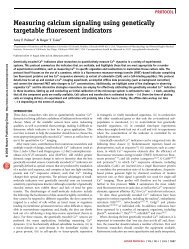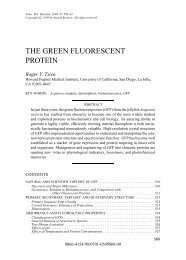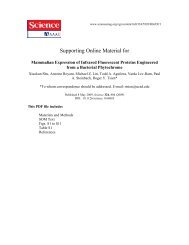Autofluorescent Proteins with Excitation in the Optical ... - Tsien
Autofluorescent Proteins with Excitation in the Optical ... - Tsien
Autofluorescent Proteins with Excitation in the Optical ... - Tsien
Create successful ePaper yourself
Turn your PDF publications into a flip-book with our unique Google optimized e-Paper software.
Chemistry & Biology<br />
Fluorescent <strong>Prote<strong>in</strong>s</strong> <strong>with</strong> Far-Red <strong>Excitation</strong><br />
average molecular weights for Neptune and mKate of 62 and 58<br />
kDa at <strong>the</strong> elution peak, consistent <strong>with</strong> dimers (Figure 3A).<br />
Average measured molecular weight <strong>in</strong> <strong>the</strong> tail is consistent<br />
<strong>with</strong> <strong>the</strong> late-elut<strong>in</strong>g subpopulation of mKate prote<strong>in</strong>s be<strong>in</strong>g<br />
predom<strong>in</strong>antly monomers (34 kDa), while late-elut<strong>in</strong>g Neptune<br />
prote<strong>in</strong>s exhibit an average molecular weight of 40 kDa, suggest<strong>in</strong>g<br />
a mix of monomers and dimers. F<strong>in</strong>ally, at similar concentrations,<br />
Neptune and mKate migrate as dimers <strong>in</strong> native gel electrophoresis<br />
but as monomers <strong>in</strong> SDS, a behavior between that of<br />
mCherry, which migrates as a monomer <strong>in</strong> both conditions, and<br />
dTomato, which migrates as a dimer <strong>in</strong> both conditions (Figures<br />
S4B and S4C). Toge<strong>the</strong>r, <strong>the</strong>se data suggest that mKate and<br />
Neptune exist <strong>in</strong> a monomer-dimer equilibrium at low micromolar<br />
concentrations.<br />
To improve its performance <strong>in</strong> fusion prote<strong>in</strong>s, we fur<strong>the</strong>r<br />
monomerized Neptune. The Y194F mutation <strong>in</strong> Neptune alters<br />
an external side cha<strong>in</strong> located adjacent to Met-146, which participates<br />
<strong>in</strong> a hydrophobic <strong>in</strong>tersubunit <strong>in</strong>teraction. Removal of<br />
a polar hydroxyl group by <strong>the</strong> Y194F mutation <strong>in</strong> Neptune might<br />
have resulted <strong>in</strong> <strong>in</strong>creased dimerization tendency. To restore<br />
a polar group near position 194, we performed saturation mutagenesis<br />
of Met-146 and found a M146T mutant that reta<strong>in</strong>ed <strong>the</strong><br />
brightness and spectral profile of Neptune (Table 1 and Figure 1),<br />
while exhibit<strong>in</strong>g enhanced dissociation <strong>in</strong>to monomers compared<br />
to mKate (Figure 3A). We performed equilibrium analytical<br />
ultracentrifugation to measure dissociation constants for<br />
Neptune and Neptune M146T. Sedimentation profiles were<br />
best fit to a monomer-dimer equilibrium model <strong>with</strong> a dissociation<br />
constant of 2.1 mM for <strong>the</strong> M146T mutant compared <strong>with</strong><br />
Figure 3. A functionally Monomeric Variant<br />
of Neptune for Prote<strong>in</strong> Fusions<br />
(A) Neptune exhibits more dimerization relative to<br />
mKate, while mNeptune exhibits less. Normalized<br />
elution profiles on size-exclusion HPLC (th<strong>in</strong><br />
traces, axis on left) and estimated molecular<br />
weights upon elution by <strong>in</strong>-l<strong>in</strong>e light scatter<strong>in</strong>g<br />
(thick traces, axis on right) are shown for dTomato<br />
(orange solid), Neptune (dark blue dashed), mNeptune<br />
(light blue solid), mKate (green dashed),<br />
mKate2 (red dashed), and mCherry (maroon solid).<br />
Dots show estimated molecular weights upon<br />
elution by <strong>in</strong>-l<strong>in</strong>e light scatter<strong>in</strong>g. <strong>Prote<strong>in</strong>s</strong> were<br />
analyzed sequentially <strong>in</strong> <strong>the</strong> same day at 5 mM <strong>in</strong><br />
PBS. mCherry and dTomato serve as monomeric<br />
and dimeric controls, respectively.<br />
(B) mNeptune-act<strong>in</strong> and mNeptune-tubul<strong>in</strong> are<br />
correctly localized upon expression <strong>in</strong> HeLa cells,<br />
similarly to mKate2 fusions. Scale bar, 10 mm.<br />
0.5 mM for Neptune (Table S3), confirm<strong>in</strong>g<br />
<strong>the</strong> <strong>in</strong>creased monomeric character of<br />
<strong>the</strong> mutant. Fusions of Neptune 146T<br />
prote<strong>in</strong>, which we refer to as mNeptune,<br />
to act<strong>in</strong> and tubul<strong>in</strong> localized correctly <strong>in</strong><br />
HeLa cells, similarly to mKate2 (Figure<br />
3B), demonstrat<strong>in</strong>g its usefulness as<br />
a monomeric fusion tag. Hydrolysis of<br />
<strong>the</strong> chromophore acylim<strong>in</strong>e <strong>in</strong> mNeptune,<br />
which occurs upon exposure of <strong>the</strong> chromophore<br />
to water dur<strong>in</strong>g prote<strong>in</strong> denaturation, was observed <strong>in</strong><br />
less than 7% of <strong>the</strong> prote<strong>in</strong> <strong>in</strong> samples aged for 4 months<br />
(Figure S4D), <strong>in</strong>dicat<strong>in</strong>g that mNeptune is structurally stable.<br />
Structural Basis of <strong>the</strong> Bathochromic Shift <strong>in</strong> Neptune<br />
Of <strong>the</strong> mutations differentiat<strong>in</strong>g Neptune from mKate S158A, no<br />
s<strong>in</strong>gle one is necessary for <strong>the</strong> majority of <strong>the</strong> bathochromic shift<br />
(Table 2), imply<strong>in</strong>g multiple additive mechanisms for red-shift<strong>in</strong>g.<br />
To explore <strong>the</strong> biophysical basis of wavelength tun<strong>in</strong>g <strong>in</strong><br />
Neptune, we determ<strong>in</strong>ed <strong>the</strong> crystal structure of Neptune at pH<br />
Table 2. Contributions of Individual Mutations to Red-Shift<strong>in</strong>g <strong>in</strong><br />
Neptune<br />
Reversion from<br />
Neptune<br />
<strong>Excitation</strong><br />
Peak a<br />
Emission<br />
Peak a<br />
none (Neptune) 600 650 72,000 0.18<br />
C61S 597 649 80,000 0.18<br />
F197Y 596 649 56,000 0.16<br />
G41M 595 637 60,000 0.21<br />
C158A 593 644 97,000 0.19<br />
C61S F197Y G41M<br />
C158A (mKate S158A)<br />
585 630 75,000 0.30<br />
C61S F197Y G41M<br />
(mKate S158C)<br />
586 630 63,000 0.33<br />
a<br />
<strong>Excitation</strong> and emission maxima <strong>in</strong> nm.<br />
b 1 1<br />
Maximum ext<strong>in</strong>ction coefficient <strong>in</strong> M cm measured by <strong>the</strong> alkali<br />
denaturation method (Chalfie and Ka<strong>in</strong>, 2006; Gross et al., 2000).<br />
c<br />
Quantum yield of fluorescence.<br />
Chemistry & Biology 16, 1169–1179, November 25, 2009 ª2009 Elsevier Ltd All rights reserved 1173<br />
3 b<br />
f c






